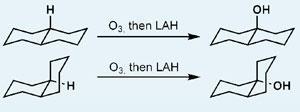US researchers discover that C-H bond reactivity is linked to whether the bond's activation will reduce strain in the molecule
Chemists have uncovered a key factor that helps determine the reactivity of a C-H bond to oxidation: how much strain will be relieved in the parent molecule when it enters the transition state during the reaction. Where two possible C-H bonds can react, the one whose activation will release most strain will react more quickly.
Until now it has been assumed that differences in reactivity between C-H bonds have been due to the different steric or electronic environments of the bond. While it has been recognised for many years that in certain molecules C-H bonds that are configured in the equatorial plane react significantly faster than those in the axial plane, no convincing explanation for the phenomenon has been forthcoming.
Now, Ke Chen and Phil Baran from the Scripps Institute in California and Albert Eschenmoser from the Swiss Federal Institute of Technology in Zurich believe they have the answer.
More than 50 years ago, Eschenmoser demonstrated that during the oxidation of steroidal alcohols with chromic acid, equatorial hydrogens were removed preferentially, and that this effect was due to the release of strain as the parent alcohol moved to its transition state. Chen and Baran noted that during the synthesis of a complex terpene, one C-H bond out of a possible five reacted much more quickly with an oxidiser than the other four. Steric and electronic considerations would not single this bond out. The researchers set out to test if the release of strain was the reason for the selective reaction.
They constructed two terpene molecules that were identical in every aspect except that one contained an extra methyl group positioned in a way to introduce strain into the structure. Each molecule had a C-H bond whose steric and electronic characteristics were nearly the same.

When the two molecules were exposed to an oxidising regime, the C-H bond of the ’strained’ molecule was significantly more reactive than that in its unstrained counterpart. ’If the ground state of the molecule is destabilised, this will lead to a faster reaction,’ says Baran. ’If the transition state is a less strained entity, the energy to achieve the transition geometry will be lower, so that reaction will be favoured.’
Baran says that the finding may help chemists to predict the relative reactivity and selectivity of C-H bond oxidation in complex contexts where steric and electronic effects alone are not sufficient for the planning of a synthesis.
Michael Willis, an organic chemist at the University of Oxford in the UK, says that the work ’proposes an elegant and potentially powerful concept to predict the reactivity profile very similar C-H bonds.’ Willis adds, ’The real utility of the model will be if it can be successfully transferred to more examples, and then allow C-H bond activations to be designed into synthetic routes towards complex targets.’
Simon Hadlington
References
K E Chen, A Eschenmoser and P Baran, Angew. Chem. Int. Ed., 2009, DOI: 10.1002/anie.200904474






No comments yet